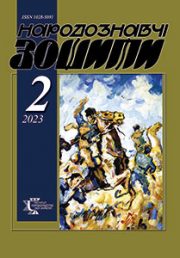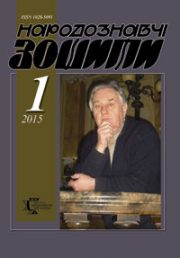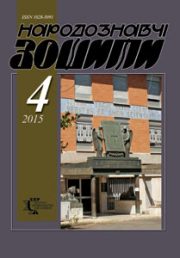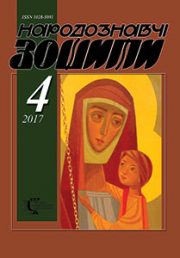The Ethnology Notebooks. 2020. № 2 (152), 461—473
UDK 712.253.034(477.83-21)(093.2)
DOI https://doi.org/10.15407/nz2020.02.461
THE GARDEN-PARK COMPLEX IN THE CITY OF KRYSTYNOPOL UNDER THE PROJECT OF PIERRE RICO DE TIERREGAILLE
TARAS Viktoriya
ORCID ID: https://orcid.org/0000-0002-9144-8331
cand. of architecture,
Senior Researcher at the Ethnology Institute
of the National Academy of Sciences of Ukraine,
15, Svobody Avenue, 79000, Lviv, Ukraine
Contacts: е-mail: vikitaras@yahoo.com
Abstract. The research of garden-park complex at the palace of Franciszek Salezy Potocki by architect Pierre Rico de Tierregaille in Krystynopol (from 1951 — Chervonograd) is selective and incomplete. To date are not known manuscripts or graphic information about its original appearance. With the changing of political situation, the castle in Krystynopol, like many other buildings of this type, gradually lost its defensive significance, becаme an ordinary magnate residence. Francis becomes the sole owner (Didych) of Krystynopol after death of his father. The voivod was planning on getting a real crown. Ambitious plans of Franciszek Salezy Potocki Franciszek Salezy Potocki needed decent «future king» residence. The architect Pierre de Tierregaille Rico (Pierre Ricaud de Tierregaille), the French military engineer helped him to make a reconstruction of the family cell who drafted the palace and garden and oversaw the construction for six years from 1756 to 1762. The project is kept in the National Archives of the city of Krakow in the collection «29/635/0 Archiwum Potockich z Krzeszowic, Sign. 3137».
Problem Statement.The article is based on these and other archival documents, analyzed composition and landscape-planning, functional, semantic solution of garden-park laying in a palace in the city of Krystynopol by the project of architect Pierre Rico de Tierregailla.
Purpose. The objective of this work is the garden-park complex in a palace in the city of Krystynopol
Methods. The article relies mainly on comparative-typological and historical-cultural approaches as well as elements of structural-typological and geographical methods of architectural studies.
Results. The architect Pierre de Tierregaille established a garden on the land of swamps, where rivers Western Bug and Solokiya merge, dedicated to the water element. The Garden had Central axis planning. It consisted of a parterre of which is adjacent to the palace and three longitudinal axial basins combined together. From the south, east and north garden surrounded by canals. Network channels and pools are functionally linked, resembling the alchemical retort, as the owner was a fan of alchemical hermetyzm. The palace complex consisted of two menagerie and a recreation palace in the village Perespa. Resting place of the owner full of luxury and entertainment life in Krystynopol served as a small palace «Cфttк de la Cour».
The authorship of this project is also attributed to Pierre de Tierregaille Rico. Consequently, the palace and park complex in Krystynopol was a real architectural pearl of its time.
Keywords: garden, park, baroque, Franciszek Salezy Potocki, Krystynopol, Pierre Ricaud de Tierregaille.
Received 19.02.2020
REFERENCES
Czernecki, J. (1939). Little King in Rus and his capital Krystynopol. Krakow [in Polish].
Mankowski, T. (1948). Architect — Pierre Ricaud de Tirregaille. Wroclaw [in Polish].
Kowalczyk, J. (1988). Pierre Ricaud de Tirregaille — architect of gardens and palaces. Architecture and Urban Planning Quarterly, 4 (Vol. 33) [in Polish].
Aftanazy, R. (1995). The history of the residence of the former frontier of the Commonwealth (Vol. 6). Warsaw [in Polish].
Cioіek, G. (1978). Polish gardens. Warsaw: Arkady [in Polish].
Majdecki, L. (2008). Garden History. From antiquity to Baroque (Vol. 1). Warsaw: PNS Publishing House [in Polish].
Bogdanowski, J. (2000). Polish decorative gardens. Warsaw: Arkady [in Polish].
Przybos, A. (1983). Potocki Feliks (Felicjan, Szczesny) Kazimierz count Pilawa (d. 1702). Polish Biographical Dictionary (Vol. XXVII/4, issue 115). Wroclaw; Warsaw; Krakow; Gdansk; Lodz: Ossolinski National Institute, Publisher of the Polish Academy of Sciences [in Polish].
Archive of Discalced Carmelites in Czerna. Manuscript 322 (P. 114); Manuscript 323 (P. 294) [in Polish].
Central State Historical Archives in Kyiv (St. 49, desc. 1, p. 2127) [in Ukrainian].
Watroba, P. (2000). Pierre Ricaud de Tirregaille unknown plan of establishing the palace and park princess Eleonora Michaіowa Czartoryska in Woіczyn. Ikonotheka. Works of the Institute of Art History at the University of Warsaw, 14, 42 [in Polish].
National Archives in Krakow. Plan of the palace of Franciszek Salezy Potocki of the Kyiv voivode in Krystynopol and the palace in Perespa. The Potocki Archives in Krzeszowice. Sign. 3137. 29/635/0/14/3137 [in French].
Czernecki, J. (1939). Little King in Rus and his capital Krystynopol. Krakow [in Polish].
National Archives of Austria. Kriegsarchiv. Josephinische Landesaufnahme, 1763—1787. B IX a 390 [in German].
National Archives of Austria. Kriegsarchiv. Galicia and Bukovina. Franziszeische Landesaufnahme, 1861—1864. B IX a 387 [in German].







